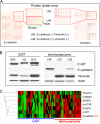Integrated proteomics and genomics analysis reveals a novel mesenchymal to epithelial reverting transition in leiomyosarcoma through regulation of slug
- PMID: 20651304
- PMCID: PMC2984227
- DOI: 10.1074/mcp.M110.000240
Integrated proteomics and genomics analysis reveals a novel mesenchymal to epithelial reverting transition in leiomyosarcoma through regulation of slug
Abstract
Leiomyosarcoma is one of the most common mesenchymal tumors. Proteomics profiling analysis by reverse-phase protein lysate array surprisingly revealed that expression of the epithelial marker E-cadherin (encoded by CDH1) was significantly elevated in a subset of leiomyosarcomas. In contrast, E-cadherin was rarely expressed in the gastrointestinal stromal tumors, another major mesenchymal tumor type. We further sought to 1) validate this finding, 2) determine whether there is a mesenchymal to epithelial reverting transition (MErT) in leiomyosarcoma, and if so 3) elucidate the regulatory mechanism responsible for this MErT. Our data showed that the epithelial cell markers E-cadherin, epithelial membrane antigen, cytokeratin AE1/AE3, and pan-cytokeratin were often detected immunohistochemically in leiomyosarcoma tumor cells on tissue microarray. Interestingly, the E-cadherin protein expression was correlated with better survival in leiomyosarcoma patients. Whole genome microarray was used for transcriptomics analysis, and the epithelial gene expression signature was also associated with better survival. Bioinformatics analysis of transcriptome data showed an inverse correlation between E-cadherin and E-cadherin repressor Slug (SNAI2) expression in leiomyosarcoma, and this inverse correlation was validated on tissue microarray by immunohistochemical staining of E-cadherin and Slug. Knockdown of Slug expression in SK-LMS-1 leiomyosarcoma cells by siRNA significantly increased E-cadherin; decreased the mesenchymal markers vimentin and N-cadherin (encoded by CDH2); and significantly decreased cell proliferation, invasion, and migration. An increase in Slug expression by pCMV6-XL5-Slug transfection decreased E-cadherin and increased vimentin and N-cadherin. Thus, MErT, which is mediated through regulation of Slug, is a clinically significant phenotype in leiomyosarcoma.
Figures




References
-
- Alves C. C., Carneiro F., Hoefler H., Becker K. F. (2009) Role of the epithelial-mesenchymal transition regulator Slug in primary human cancers. Front. Biosci. 14, 3035–3050 - PubMed
-
- Olmeda D., Moreno-Bueno G., Flores J. M., Fabra A., Portillo F., Cano A. (2007) SNAI1 is required for tumor growth and lymph node metastasis of human breast carcinoma MDA-MB-231 cells. Cancer Res. 67, 11721–11731 - PubMed
-
- Yang M. H., Chen C. L., Chau G. Y., Chiou S. H., Su C. W., Chou T. Y., Peng W. L., Wu J. C. (2009) Comprehensive analysis of the independent effect of twist and snail in promoting metastasis of hepatocellular carcinoma. Hepatology 50, 1464–1474 - PubMed
Publication types
MeSH terms
Substances
Grants and funding
LinkOut - more resources
Full Text Sources
Research Materials
Miscellaneous

